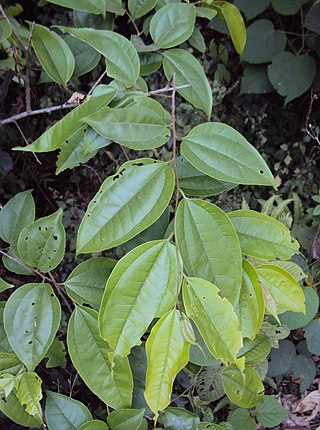
The Javan rusa or Sunda sambar is a large deer species native to Indonesia and East Timor. Introduced populations exist in a wide variety of locations in the Southern Hemisphere.

Varanus timorensis, the Timor monitor or spotted tree monitor, is a species of small monitor lizards native to the island of Timor and some adjacent islands.
The Timor rat is a species of rodent in the family Muridae found in Indonesian West Timor, where it lives in the teak forests. It is known from a specimen collected near the summit of Mount Mutis.

Moyo is an island in Indonesia's West Nusa Tenggara province. It is off the north coast of Sumbawa Island and has an area of 349 km2. Moyo Island is located in Sumbawa Regency within the Nusa Tenggara province, just north of Sumbawa. The island has an area of 32,044 hectares, about 8° south of the equator. The island is proposed as part of Moyo Satonda National Park along with Satonda Island.
Neocyprideis timorensis is a species of Indo-Pacific ostracod that has existed since the Miocene.

Celtis timorensis, commonly known as stinkwood or stinking wood, is a species of flowering plant in the family Cannabaceae that grows in tropical Asia. The specific epithet comes from the name of the island of Timor, the locality of the type collection. The most notable characteristic of the tree is the strong excrement odour that it emits from the bark and sap, which pervades the surrounding forest. This is due to the presence of the malodorous organic compound skatole. In Thailand, it therefore known as kæ̂ng k̄hī̂ phrar̀wng or mị̂ chĕd tūd phrar̀wng which means 'wipe the bottom timber'. Thai legend has it that Phra Ruang wiped his buttocks with it. In Sri Lanka the heartwood of the tree is used as a traditional ayurvedic medicine against syphilis, chickenpox, and measles.

Limnonectes timorensis is a species of frogs in the family Dicroglossidae. It is endemic to the island of Timor at the eastern end of the Lesser Sunda Islands. In Timor-Leste it is an infrequent species associated with rivers in tropical montane forests above 1000 m altitude.

Acalolepta is a genus of flat-faced longhorns beetle belonging to the family Cerambycidae, subfamily Lamiinae. Its members are found in the Indomalayan realm.
The earthworm snake-eelYirrkala lumbricoides, is an eel in the family Ophichthidae. It is a tropical, marine eel which is known from the Indo-Pacific. It is known to dwell at a depth of 20 metres. Males can reach a total length of 44 centimetres.
Acalolepta griseofasciata is a species of beetle in the family Cerambycidae. It was described by Stephan von Breuning in 1935, originally under the genus Dihammus. It is known from Papua New Guinea, Vanuatu, and the Solomon Islands.
Acalolepta sikkimensis is a species of beetle in the family Cerambycidae. It was described by Stephan von Breuning in 1935.
Acalolepta magnetica is a species of beetle in the family Cerambycidae. It was described by Francis Polkinghorne Pascoe in 1866, originally under the genus Monochamus. It is known from Micronesia, Moluccas and Indonesia.
Acalolepta permutans is a species of beetle in the family Cerambycidae. It was described by Francis Polkinghorne Pascoe in 1857, originally under the genus Monohammus. It is known from Japan, Vietnam, Taiwan, and China. It feeds on Albizia julibrissin.
Acalolepta montana is a species of beetle in the family Cerambycidae. It was described by Per Olof Christopher Aurivillius in 1916. It is known from Sulawesi.
Acalolepta flocculata is a species of beetle in the family Cerambycidae. It was described by Gressitt in 1935. It is known from Taiwan and China.

Acalolepta fraudatrix is a species of beetle in the family Cerambycidae. It was described by Henry Walter Bates in 1873. It is known from Korea, Japan, China, and Russia.
Acalolepta mixta is a species of beetle in the family Cerambycidae. It was described by Frederick William Hope in 1841, originally under the genus Monohammus. It is known from Australia, and was introduced to the Solomon Islands, Indonesia, Singapore and Vietnam. It feeds on Theobroma cacao, Adansonia digitata, Mangifera indica, Excoecaria agallocha, and Moringa oleifera.
Acalolepta rusticatrix is a species of beetle in the family Cerambycidae. It was described by Johan Christian Fabricius in 1801, originally under the genus Lamia. It is known from Myanmar, India, the Philippines, Malaysia, Sumatra, Sri Lanka, Java, Taiwan, Indonesia, Sulawesi, and Vietnam.
Acalolepta sejuncta is a species of beetle in the family Cerambycidae. It was described by Henry Walter Bates in 1873. It is known from Japan.






